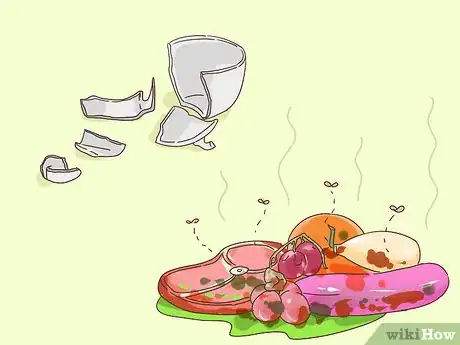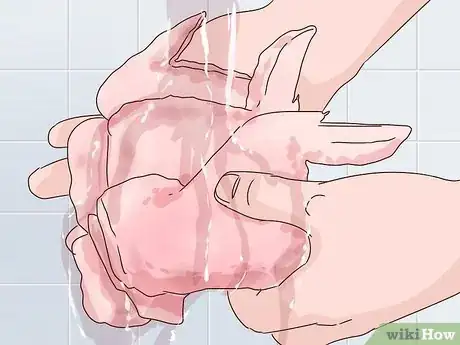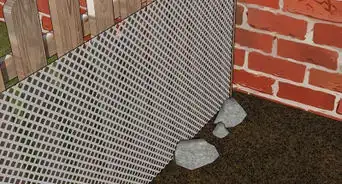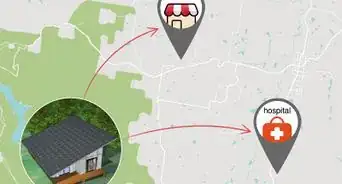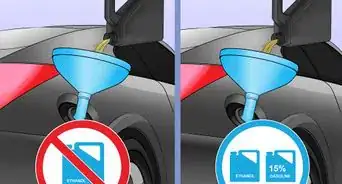This article was co-authored by wikiHow Staff. Our trained team of editors and researchers validate articles for accuracy and comprehensiveness. wikiHow's Content Management Team carefully monitors the work from our editorial staff to ensure that each article is backed by trusted research and meets our high quality standards.
There are 12 references cited in this article, which can be found at the bottom of the page.
wikiHow marks an article as reader-approved once it receives enough positive feedback. This article received 11 testimonials and 84% of readers who voted found it helpful, earning it our reader-approved status.
This article has been viewed 892,138 times.
Learn more...
As the saying goes, one man’s trash is another man’s treasure. Though it may strike some people as an odd practice, dumpster diving, or scavenging for useful items in waste receptacles, is a great way to make sure that perfectly good items aren’t going to waste. Dumpster diving doesn’t require any special skill or equipment, but it will benefit you to be aware some of the risks and learn the best way to go about it to avoid illness or legal trouble. Whether you’re looking to furnish your home, stock your refrigerator or turn trash into cash, learning the ins and outs of dumpster diving can make your searches more fruitful.
Steps
Preparing to Go Dumpster Diving
-
1Familiarize yourself with your local laws. Before you jump in headfirst, it will be worth knowing the legal risks you face for reclaiming waste items from public containers. In most places, trash is not considered private property, so it’s unlikely that you’ll be charged with theft. However, it’s possible for dumpster divers to be targeted for other offenses, such as invasion of privacy, trespassing or vagrancy.[1]
- Dumpster diving is generally frowned upon in polite society, even in places where it’s technically legal.
- If there are fences, locks or “No Trespassing” signs on the premises, consider yourself warned. It may be wise to stay away from locations under tight scrutiny.
-
2Scope out the dumpsters in your area. As most people already know, you can typically find trash receptacles outside of major businesses, but you might also expand your hunting radius to include urban neighborhoods, schools, churches and public locations like parks and beaches. To avoid detection, look for dumpsters that aren’t in plain sight.Advertisement
-
3Know what sorts of items to look for. Public trash disposal sites often contain a wealth of treasures just waiting to be claimed. Thrifty divers have been known to uncover designer clothing, valuable scrap materials and even expensive out-of-date electronics in the refuse of high-end establishments. Having a basic idea of what's out there and where you're likely to find it will help you focus your search.
- If you’re looking for a specific type of find, the smartest place to look is at the source. For example, you’ll have a much better chance stumbling upon unused beauty products behind a cosmetics boutique, or turning up small electronics at an office supply store.[4]
- Keep an eye out for old, unwanted furniture and appliances near dumpsters in residential areas.
-
4Prepare yourself mentally. Willing yourself to climb into a hot, smelly dumpster isn’t always easy since most people have an aversion to objects like garbage that they find disgusting. It can help to take a few moments to collect yourself before setting out. Remember why you’re doing what you’re doing, and keep in mind that playing a part in helping eliminate unnecessary waste.[5]
- Dumpster diving can be messy work. It may not be the best pastime for the faint of heart or those with weak stomachs.
Making a Successful Score
-
1Dress appropriately. There’s a good chance that whatever you wear is going to get dirty or torn, so wear older garments that you don’t mind ruining. Comfortable clothing will allow you to move around freely, which can be helpful should you have to do any climbing or other maneuvering. It’s also a good idea to pull on a pair of thick-soled, closed-toed shoes or boots to protect your feet from sharp exposed edges.[6]
- Wear pants and tops with long sleeves to minimize your exposure to unsanitary messes.
- If you’re going to actually enter the dumpster, wear sturdy fabrics like denim, nylon or leather and keep as much of your body covered as possible.
- Remove any accessories you don’t want to lose before you get inside.
-
2Equip other useful gear. Feel free to bring along anything else that you think might come in handy, like a pair of thick gloves or a small stepping stool or milk crate to help you get up into the dumpster. Night dives should be accompanied by a flashlight or headlamp to make it easier to see. Don’t forget to also bring some kind of spacious container to stash your discoveries in.
- A durable canvas laundry bag can make a great way to transport your finds back home.
- Use a long pole to poke around in the trash until something catches your attention. If you’re careful enough, there may be no need to get inside the receptacle at all.
- Flashlights may also be necessary during the daytime if the dumpster is especially deep or situated in the shade.
-
3Take only what you can realistically use. While you may be tempted to bring back anything and everything of potential value from your dive, it’s best to limit your haul to the things you have a specific need for. Otherwise, useless items will just accumulate and eventually find their way into the trash again.
- Organize your finds into a few separate piles: things you can use, things other people might be able to use and things you can sell.[7]
- If you don’t find anything worth keeping, cut your losses and move on to the next spot.
-
4Stay vigilant. As mentioned, dumpster diving is looked upon with notoriety. If you’re not paying attention, you may end up being surprised by random onlookers, business owners or even the police. Keep a watchful eye over your surroundings at all times, or have a friend or fellow dumpster diver on standby to signal you if someone approaches.[8]
- Spend as little time in the area as you can. Get in, get the goods and get out.
- Be ready to abandon your hunt at a moment’s notice.
-
5Don’t leave behind a mess. If you’ve removed anything from the dumpster during your search, be sure to return it before you go on your way. While you’re at it, look around for other trash nearby that you can throw away. Try to leave the area as clean—or even cleaner—than you found it.[9]
- Giving away your presence makes you more likely to be caught red-handed on future visits.
- The goal is to economize, not to vandalize. Don’t give dumpster diving a bad name.
Dumpster Diving for Food
-
1Go where the food is. If you set out with the goal of replenishing your pantry, it will be helpful to know where to go for salvageable food items that aren't an obvious health hazard. You can almost always find something of use behind restaurants and supermarkets. Cafes and bakeries are another dependable source, as they're required to dispose of freshly-prepared food items at the end of the day. Most of the time, these items won't have been left sitting long enough to have gone bad.[10]
- A good general rule is to start your search at a place that sells the type of food you're looking for.
- Dumpster diving at popular stores and restaurants is best left for the nighttime hours when you're less likely to be noticed.[11]
-
2Salvage preserved food items first. Things packaged in boxes, jars and wrappers tend to last longer than fresh foods because they receive less exposure to the bacteria in the air. These sorts of goods should always be your first choice when on the hunt for a meal. Look for items that are still in their airtight packaging, like canned tuna or individually wrapped granola bars.[12]
- Avoid anything that's not sealed or has been previously opened.
- Canned and dried goods (such as uncooked rice, oats and pasta) usually stay good for several months after their listed expiration date.[13]
-
3Use out-of-date foods immediately. A bag of soft avocados or a case of mayonnaise may still be safe to eat, but you should try to find something to do with them right away. The best way to make various edible discoveries stretch if they're nearing (or just past) their prime is to incorporate them into other foods. For instance, a bunch of brown bananas isn't particularly appetizing on its own, but it will go perfectly in a loaf of bread or a fruit smoothie.[14]
- Cook as much of what you bring back as you can. This will kill off the harmful bacteria that begins to reproduce when food spoils and may also level out stale and unpleasant flavors.[15]
- Most types of produce can be canned, pickled or turned into jams or jellies, effectively extending their lifespan.
-
4Stay away from questionable items. It should go without saying, but use your common sense—if you come across food that's noticeably rotten or has a foul odor, don't eat it. The majority of meats, dairy products, fruits and vegetables that find their way into the garbage fit into this category. Though they're enticing, perishables are invariably the first to go bad. You're better off setting your sights on foods that fare well in a wide range of storage conditions and using your best judgment.[16]
- If you do decide to take it with you anyway, double-check it for signs of mold or tampering first, and be aware of the risk you're taking to your health.
- Never consume frozen or refrigerated items after they've thawed to room temperature. This could make you extremely sick.[17]
Staying Safe and Hygienic
-
1Rummage through trash receptacles cautiously. You never know what might be lurking at the bottom of a dumpster or recycling bin. Broken glass, rotting food, hazardous materials and other types of waste all pose a potential threat to your health. Proceed slowly and cautiously while sifting through unidentified rubbish, especially if it’s hard to see what’s around you.
- Prop open the lid of the dumpster or have a friend hold it for you so you can work unimpeded.[18]
-
2Watch out for pests. Trash receptacles are sometimes home to rats, opossums, raccoons and other scavengers. When startled or provoked, these animals may be motivated to attack. Give the inside of the dumpster a quick once-over before climbing inside to avoid a surprise encounter with a potentially dangerous pest. Banging the outside of the dumpster may also help scare off any unwanted company.
- If the dumpster you're attempting to search is inhabited by critters, the safest option is to just move on to the next location.
- Scavenger rodents are known for carrying diseases that can prove fatal to humans if contracted. Keep your distance at all costs.
-
3Bathe yourself immediately. As soon as you get back home, hop in the shower to clean off any dirt and germs you may have encountered during your dive. Wash with hot water and an antibacterial soap, and don’t forget to shampoo. Pay special attention to areas that tend to get missed, like inside your ears and beneath your fingernails.
- Prolonged or unsafe exposure to garbage can lead to a host of health concerns.[19]
- Contrary to popular belief, a solid personal hygiene regimen is very important for dumpster divers—arguably even more important than for normal people.
-
4Clean retrieved items thoroughly. Soak non-electronic finds with warm water and a strong disinfectant to kill bacteria and remove mold and other residue. Rinse salvageable foodstuffs like produce and packaged snacks with clean water, then store them properly or cook and use them immediately. After a good cleaning, most discoveries will be restored to top shape.[20]
- Spot clean electronics with a washcloth and rubbing alcohol or mild liquid detergent.
- Food items should receive special attention, as it can be extremely unsafe to eat anything that’s spoiled or contaminated.[21]
Community Q&A
-
QuestionCan I go dumpster-driving in the trash at the mall?
 AdrianTop AnswererIf there are no signs, then yes.
AdrianTop AnswererIf there are no signs, then yes. -
QuestionHow do I convince my parents to take me dumpster diving?
 Community AnswerLet them know what kind of useful discoveries you can make and how many of them are still in perfectly serviceable condition. Reclamation is not the same thing as stealing. Consumer waste is a growing concern in many countries, and activities like dumpster diving, when practiced safely and responsibly, can help reduce the strain placed on the environment and benefit municipal areas where overaccumulation of trash has become a problem.
Community AnswerLet them know what kind of useful discoveries you can make and how many of them are still in perfectly serviceable condition. Reclamation is not the same thing as stealing. Consumer waste is a growing concern in many countries, and activities like dumpster diving, when practiced safely and responsibly, can help reduce the strain placed on the environment and benefit municipal areas where overaccumulation of trash has become a problem. -
QuestionWhat is the best time of day to go dumpster diving?
 Community AnswerTry to go after the store's closing hours to avoid confrontation. Going before the store opens is not always a good idea, as the stock and receiving crew often work early hours.
Community AnswerTry to go after the store's closing hours to avoid confrontation. Going before the store opens is not always a good idea, as the stock and receiving crew often work early hours.
Warnings
- Trash is thrown away for a reason. Anytime you come into contact with rubbish, you place yourself at risk of illness, injury or disease.⧼thumbs_response⧽
- If you receive any cuts or scrapes while digging through a trash receptacle, treat them with an antiseptic right away to prevent them from becoming infected.⧼thumbs_response⧽
- If you’re confronted by the police, don’t attempt to run. More than likely you’ll be caught, and even if you manage to get away, it will only make things harder for you the next time you go diving. Always be polite, truthful and cooperative when dealing with law enforcement.⧼thumbs_response⧽
- Never ingest any food items that smell bad or show signs of mold or decay.⧼thumbs_response⧽
Things You'll Need
- Comfortable clothing that allows you to move freely
- Protective footwear
- Thick gloves
- Long-handled probing device
- Flashlight or headlamp
- Separate container for carrying off your finds
- Soaps, disinfectants and sanitizers
References
- ↑ https://www.wired.com/2015/02/high-end-dumpster-diving-matt-malone/
- ↑ https://www.robgreenfield.org/dumpsterdivingtips/
- ↑ http://blog.kragtbakker.com/post/3321213755/a-shout-out-to-eating-garbage-on-dumpster-diving
- ↑ https://www.robgreenfield.org/dumpsterdivingtips/
- ↑ https://www.robgreenfield.org/dumpsterdivingtips/
- ↑ http://www.kellyelko.com/2013/04/dumpster-diving-tips-from-a-pro/
- ↑ https://www.wired.com/2015/02/high-end-dumpster-diving-matt-malone/
- ↑ https://www.robgreenfield.org/dumpsterdivingtips/
- ↑ http://blog.kragtbakker.com/post/3321213755/a-shout-out-to-eating-garbage-on-dumpster-diving
- ↑ http://robgreenfield.tv/dumpsterdiving/
- ↑ http://www.mnn.com/lifestyle/recycling/stories/the-classy-dive-the-dos-and-donts-of-dumpster-diving
- ↑ http://www.mnn.com/lifestyle/recycling/stories/the-classy-dive-the-dos-and-donts-of-dumpster-diving
- ↑ http://www.webmd.com/a-to-z-guides/features/do-food-expiration-dates-matter
- ↑ http://www.mnn.com/lifestyle/recycling/stories/the-classy-dive-the-dos-and-donts-of-dumpster-diving
- ↑ https://www.foodsafety.gov/keep/basics/cook/
- ↑ http://www.shareable.net/blog/how-to-dumpster-dive-eat-free-fight-waste
- ↑ http://www.theglobeandmail.com/life/health-and-fitness/health/food-safety-risk-isnt-in-freezing-but-in-thawing-experts-say/article15261778/
- ↑ https://www.robgreenfield.org/dumpsterdivingtips/
- ↑ https://www.cdc.gov/Mmwr/preview/mmwrhtml/mm5436a2.htm
- ↑ https://garbagefinds.com/
- ↑ http://robgreenfield.tv/dumpsterdiving/
About This Article
To dumpster dive, start by dressing in old, comfortable clothes that you don’t mind getting dirty or torn. Next pack thick gloves, a stepping stool, flashlight, and any other gear that you think might come in handy. Then, search for a dumpster that’s not in plain sight, or surrounded by fences with locks or “No Trespassing” signs. As you look through the dumpster, remember to only take what you can use or sell. Once you’re done looking, put back the things you’re not taking and clean up the area as much as you can. For more advice, including how to stay safe and hygienic during a dumpster dive, keep reading.













